Automated Quantitative Characterization REE Ore Mineralogy from the Giant Bayan Obo Deposit, Inner Mongolia, China
Abstract
:1. Introduction
2. Geological Context
3. Samples and Methods
3.1. Sample Collection
3.2. Automated Mineralogy (TIMA) Analysis
4. Results
4.1. Summary of the Quantitative Mineralogy of the Studied REE Ores
4.2. Description of the REE Ore Mineralogy from Different Depths
4.2.1. Sample 1107 m
4.2.2. Sample 1246 m
4.2.3. Sample 1406 m
4.2.4. Sample 1546 m
4.2.5. Sample 1682 m
4.2.6. Other Types of Mineralization
5. Discussion
6. Conclusions
Supplementary Materials
Author Contributions
Funding
Data Availability Statement
Acknowledgments
Conflicts of Interest
References
- USGS. Rare Earths. In Mineral Commodity Summaries; US Geological Survey: Reston, VA, USA, 2021; pp. 132–133. [Google Scholar]
- Ling, M.X.; Liu, Y.L.; Williams, I.S.; Teng, F.Z.; Yang, X.Y.; Ding, X.; Wei, G.J.; Xie, L.H.; Deng, W.F.; Sun, W.D. Formation of the world’s largest REE deposit through protracted fluxing of carbonatite by subduction-derived fluids. Sci. Rep. 2013, 3, srep01776-8. [Google Scholar]
- Huang, X.W.; Zhou, M.F.; Qiu, Y.Z.; Qi, L. In-situ LA-ICP-MS trace elemental analyses of magnetite: The Bayan Obo Fe-REE-Nb deposit, North China. Ore Geol. Rev. 2015, 65, 884–899. [Google Scholar] [CrossRef]
- Tang, H.Y.; Liu, Y.; Song, W.L. Igneous genesis of the Bayan Obo REE–Nb–Fe deposit: New petrographical and structural evidence from the H1–H9 cross-section and deep-drilling exploration. Ore Geol. Rev. 2021, 138, 104397. [Google Scholar] [CrossRef]
- Drew, L.J.; Meng, Q.R.; Sun, W.J. The Bayan Obo iron-rare-earth-niobium deposits, Inner Mongolia, China. Lithos 1990, 26, 43–65. [Google Scholar] [CrossRef]
- Ren, Y.S.; Yang, X.X.; Wang, S.S.; Öztürk, H.Y. Mineralogical and geochemical study of apatite and dolomite from the Bayan Obo giant Fe-REE-Nb deposit in Inner Mongolia: New evidences for genesis. Ore Geol. Rev. 2019, 109, 381–406. [Google Scholar] [CrossRef]
- Yang, X.Y.; Lai, X.D.; Ren, Y.S.; Ling, M.X.; Liu, Y.L.; Liu, J.Y. Geological characteristics and their scientific problems of the Bayan Obo Fe-REE-Nb deposit: Discussion on the origin of Bayan Obo super-large deposit. Acta Geol. Sin. 2015, 89, 2323–2350. (In Chinese) [Google Scholar]
- Ye, L.; Cook, N.J.; Ciobanu, L.C.; Liu, Y.P.; Zhang, Q.; Liu, T.G.; Gao, W.; Yang, Y.L.; Danyushevskiy, L. Trace and minor elements in sphalerite from base metal deposits in South China: A LA–ICPMS study. Ore Geol. Rev. 2011, 39, 188–217. [Google Scholar]
- Ward, I.; Merigot, K.; Mcinnes, B.I.A. Application of quantitative mineralogical analysis in archaeological micromorphology: A case study from Barrow Is., Western Australia. J. Archaeol. Method Theory 2018, 25, 45–68. [Google Scholar] [CrossRef]
- Hrstka, T.; Gottlieb, P.; Skála, R.; Breiter, K.; Motl, D. Automated mineralogy and petrology-applications of TESCAN Integrated Mineral Analyzer (TIMA). J. Geosci. 2018, 63, 47–63. [Google Scholar] [CrossRef] [Green Version]
- Chen, Q.; Song, W.L.; Yang, J.K.; Hu, Y.; Huang, J.; Zhang, T.; Zheng, G.S. Principle of automated mineral quantitative analysis system and its application in petrology and mineralogy: An example from TESCAN TIMA. Miner. Depos. 2021, 40, 345–368. (In Chinese) [Google Scholar]
- Sindern, S.; Meyer, F.M. Automated quantitative rare earth elements mineralogy by scanning electron microscopy. Phys. Sci. Rev. 2016, 1, 20160063. [Google Scholar] [CrossRef]
- Breiter, K.; Durisova, J.; Hrstka, T.; Korbelova, Z.; Vankova, M.H.; Galiovaa, M.V.; Kanicky, V.; Rambousek, P.; Knesl, I.; Dobes, P.; et al. Assessment of magmatic vs. metasomatic processes in rare-metal granites: A case study of the Cinovec/Zinnwald Sn-W-Li deposit, Central Europe. Lithos 2017, 292, 198–217. [Google Scholar] [CrossRef]
- Xu, C.; Kynicky, J.; Song, W.L.; Tao, R.B.; Lu, Z.; Li, Y.X.; Yang, Y.C.; Pohanka, M.; Galiova, M.V.; Zhang, L.F.; et al. Cold deep subduction recorded by remnants of a Paleoproterozoic carbonated slab. Nat. Commun. 2018, 9, 2790. [Google Scholar] [CrossRef] [PubMed] [Green Version]
- Aylmore, M.G.; Merigot, K.; Quadir, Z.; Rickard, W.D.A.; Evans, N.J.; McDonald, B.J.; Catovic, E.; Spitalny, P. Applications of advanced analytical and mass spectrometry techniques to the characterisation of micaceous lithium-bearing ores. Miner. Eng. 2018, 116, 182–195. [Google Scholar] [CrossRef]
- Beinlich, A.; John, T.; Vrijmoed, J.C.; Tominaga, M.; Magna, T.; Podladchikov, Y.Y. Instantaneous rock transformations in the deep crust driven by reactive fluid flow. Nat. Geosci. 2020, 13, 307–311. [Google Scholar] [CrossRef]
- Keulen, N.; Malkki, S.N.; Graham, S. Automated quantitative mineralogy applied to metamorphic rocks. Minerals 2020, 10, 47. [Google Scholar] [CrossRef] [Green Version]
- Song, W.L.; Xu, C.; Smith, M.P.; Chakhmouradian, A.R.; Brenna, M.; Kynický, J.; Chen, W.; Yang, Y.H.; Deng, M.; Tang, H.Y. Genesis of the world’s largest rare earth element deposit, Bayan Obo, China: Protracted mineralization evolution over ~1 b.y. Geology 2018, 46, 323–326. [Google Scholar] [CrossRef]
- Chao, E.T.C.; Minkin, J.A.; BACK, J.M.; Okita, P.M.; Mckee, E.H.; Tosdal, R.M.; Tatsumoto, M.; Wang, J.; Edwards, C.A.; Ren, Y.; et al. The H8 dolomite host rock of the Bayan Obo iron-niobium-rare earth-element ore deposit of Inner Mongolia, China-origin, episodic mineralization, and implications. USGS Circ. 1989, 1035, 8–10. [Google Scholar]
- Yuan, Z.X.; Bai, G.; Wu, C.X.; Zhang, Z.Q.; Ye, X.J. Geological features and genesis of the Bayan Obo REE ore deposit, Inner Mongolia, China. Appl. Geochem. 1992, 7, 429–442. [Google Scholar]
- Smith, M.P.; Campbell, L.S.; Kynicky, J. A review of the genesis of the world class Bayan Obo Fe-REE-Nb deposits, Inner Mongolia, China: Multistage processes and outstanding questions. Ore Geol. Rev. 2015, 64, 459–476. [Google Scholar] [CrossRef]
- She, H.D.; Fan, H.R.; Yang, K.F.; Li, X.; Yang, Z.F.; Wang, Q.W.; Zhang, L.F.; Wang, Z.J. Complex, multistage mineralization processes in the giant Bayan Obo REE-Nb-Fe deposit, China. Ore Geol. Rev. 2021, 139, 104461. [Google Scholar] [CrossRef]
- Wang, K.Y.; Fan, H.R.; Xie, Y.H.; Li, H.M. U-Pb dating of zircons in basement complex of Bayan Obo giant REE-Nb-Fe deposit. Chin. Sci. Bull. 2001, 46, 1390–1393. (In Chinese) [Google Scholar]
- Fan, H.R.; Yang, K.F.; Hu, F.F.; Wang, K.Y.; Zhai, M.G. Zircon geochronology of basement rocks from the Bayan Obo area, Inner Mongolia, and tectonic implications. Acta Geosci. Sin. 2010, 26, 1342–1350. (In Chinese) [Google Scholar]
- Zhong, Y.; Zhai, M.G.; Peng, P.; Santosh, M.; Ma, X.D. Detrital zircon U-Pb dating and whole-rock geochemistry from the clastic rocks in the northern marginal basin of the North China Craton: Constraints on depositional age and provenance of the Bayan Obo Group. Precambrian Res. 2015, 258, 133–145. [Google Scholar]
- Lai, X.D.; Yang, X.Y.; Liu, Y.L.; Yan, Z.Q. Genesis of the Bayan Obo Fe–REE–Nb deposit: Evidences from Pb–Pb age and microanalysis of the H8 formation in Inner Mongolia, North China Craton. J. Asian Earth Sci. 2016, 120, 87–99. [Google Scholar] [CrossRef]
- Liu, C.H.; Zhao, G.C.; Liu, F.L.; Shi, J.R. Detrital zircon U-Pb and Hf isotopic and whole-rock geochemical study of the Bayan Obo Group, northern margin of the North China Craton: Implications for Rodinia reconstruction. Precambrian Res. 2017, 303, 372–391. [Google Scholar] [CrossRef]
- IGCAS. Geochemistry of Bayan Obo Deposit; Science Press: Beijing, China, 1988. (In Chinese) [Google Scholar]
- Liu, S.; Fan, H.R.; Yang, K.F.; Hu, F.F.; Rusk, B.; Liu, X.; Li, X.C.; Yang, Z.F.; Wang, Q.W.; Wang, K.Y. Fenitization in the giant Bayan Obo REE-Nb-Fe deposit: Implication for REE mineralization. Ore Geol. Rev. 2018, 94, 290–309. [Google Scholar] [CrossRef]
- Yang, K.F.; Fan, H.Y.; Pirajno, F.; Li, X.C. The Bayan Obo (China) giant REE accumulation conundrum elucidated by intense magmatic differentiation of carbonatite. Geology 2019, 47, 1198–1202. [Google Scholar] [CrossRef] [Green Version]
- Yang, X.M.; Yang, X.Y.; Zheng, Y.F.; Le Bas, M.J. A rare earth element-richcarbonatite dyke at Bayan Obo, Inner Mongolia, North China. Mineral. Petrol. 2003, 78, 93–110. [Google Scholar] [CrossRef]
- Ni, P.; Zhou, J.; Chi, Z.; Pan, J.Y.; Li, S.N.; Ding, J.Y.; Han, L. Carbonatite dyke and related REE mineralization in the Bayan Obo REE ore field, North China: Evidence from geochemistry, C-O isotopes and Rb-Sr dating. J. Geochem. Explor. 2020, 215, 106560. [Google Scholar] [CrossRef]
- Fan, H.R.; Yang, K.F.; Hu, F.F.; Liu, S.; Wang, K.Y. The giant Bayan Obo REE-Nb-Fe deposit, China: Controversy and ore genesis. Geosci. Front. 2016, 7, 41–50. [Google Scholar] [CrossRef]
- Yang, X.Y.; Lai, X.D.; Pirajno, F.; Liu, Y.L.; Ling, M.X.; Sun, W.D. Genesis of the Bayan Obo Fe-REE-Nb formation in Inner Mongolia, North China Craton: A perspective review. Precambrian Res. 2017, 288, 39–71. [Google Scholar] [CrossRef]
- Zhang, S.H.; Zhao, Y.; Liu, Y.S. A precise zircon Th-Pb age of carbonatite sills from the world’s largest Bayan Obo deposit: Implications for timing and genesis of REE-Nb mineralizations. Precambrian Res. 2017, 291, 202–219. [Google Scholar] [CrossRef]
- Chao, E.C.T.; Back, J.M.; Minkin, J.A.; Ren, Y.C. Host-rock controlled epigenetic, hydrothermal metasomatic origin of the Bayan Obo REE-Fe-Nb ore deposit, Inner Mongolia, PRC. Appl. Geochem. 1992, 7, 443–458. [Google Scholar] [CrossRef]
- Fan, H.R.; Hu, F.F.; Yang, K.F.; Wang, K.Y. Fluid unmixing/immiscibility as an ore-forming process in the giant REE–Nb–Fe deposit, Inner Mongolian, China: Evidence from fluid inclusions. J. Geochem. Explor. 2006, 89, 104–107. [Google Scholar] [CrossRef]
- Campbell, L.S.; Compston, W.; Sircombe, K.N.; Wilkinson, C.C. Zircon from the East Orebody of the Bayan Obo Fe–Nb–REE deposit, China, and SHRIMP ages for carbonatite-related magmatism and REE mineralization events. Contrib. Mineral. Petrol. 2014, 168, 1041. [Google Scholar] [CrossRef] [Green Version]
- Zhu, X.K.; Sun, J.; Pan, C.X. Sm-Nd isotopic constraints on rare-earth mineralization in the Bayan Obo ore deposit, Inner Mongolia, China. Ore Geol. Rev. 2015, 64, 543–553. [Google Scholar] [CrossRef]
- Chao, E.C.T.; Back, J.M.; Minkin, J.A.; Tatsumoto, M.; Wang, J.; Conrad, J.E.; MaKee, E.H.; Hou, Z.; Meng, Q.S. The sedimentary carbonate-hosted giant Bayan Obo REE-Fe-Nb ore deposit of Inner Mongolia, China: A cornerstone example for giant polymetallic ore deposits of hydrothermal original. USGS Bull. 1997, 2143, 1–65. [Google Scholar]
- Smith, M.P.; Henderson, P.; Campbell, L.S. Fractionation of the REE during hydrothermal processes: Constraints from the Bayan Obo Fe-REE-Nb deposit, Inner Mongolia, China. Geochim. Cosmochim. Acta 2000, 64, 3141–3160. [Google Scholar] [CrossRef]
- Yang, X.Y.; Sun, W.D.; Zhang, Y.X.; Zheng, Y.F. Geochemical constraints on the genesis of the Bayan Obo Fe-Nb-REE deposit in Inner Mongolia, China. Geochim. Cosmochim. Acta 2009, 73, 1417–1435. [Google Scholar] [CrossRef]
- Chen, W.; Liu, H.Y.; Lu, J.; Jiang, S.Y.; Simonetti, A.; Xu, C.; Zhang, W. The formation of the ore-bearing dolomite marble from the giant Bayan Obo REE-Nb-Fe deposit, Inner Mongolia: Insights from micron-scale geochemical data. Miner. Depos. 2020, 55, 131–146. [Google Scholar] [CrossRef]
- Smith, M.P.; Henderson, P.; Zhang, P. Reaction relationship in the Bayan Obo Fe-REE-Nb deposit, Inner Mongolia, China: Implications for the relative stability of rare-earth element phosphates and fluorocarbonates. Contrib. Mineral. Petrol 1999, 134, 294–310. [Google Scholar] [CrossRef]
- Giebel, R.J.; Gauert, C.D.; Marks, M.A.; Costin, G.; Markl, G. Multistage formation of REE minerals in the Palabora Carbonatite Complex, South Africa. Am. Mineral. 2017, 102, 1218–1233. [Google Scholar] [CrossRef]
- Smith, M.P.; Henderson, P. Preliminary fluid inclusion constraints on fluid evolution in the Bayan Obo Fe-REE-Nb deposit, Inner Mongolia, China. Econ. Geol. 2000, 95, 1371–1388. [Google Scholar] [CrossRef] [Green Version]
- Fan, H.R.; Xie, Y.H.; Wang, K.Y.; Tao, K.J.; Wilde, S.A. REE daughter minerals trapped in fluid inclusions in the giant Bayan Obo REE-Nb-Fe deposit, Inner Mongolia, China. Int. Geol. Rev. 2004, 46, 638–645. [Google Scholar] [CrossRef]
- Walter, B.F.; Giebel, R.J.; Steele-MacInnis, M.; Marks, M.A.; Kolb, J.; Markl, G. Fluids associated with carbonatitic magmatism: A critical review and implications for carbonatite magma ascent. Earth-Sci. Rev. 2021, 215, 103509. [Google Scholar] [CrossRef]
- Bühn, B.; Rankin, A.H. Composition of natural, volatile-rich Na-Ca-REE-Sr carbonatitic fluids trapped in fluid inclusions. Geochim. Cosmochim. Acta 1999, 63, 3781–3797. [Google Scholar] [CrossRef]
- Zhang, H.D.; Zhai, M.G.; Wang, D.Q.; Fayek, M.; Liu, J.C. Dating of monazite-apatite-allanite-epidote corona from the Bayan Obo Group in the northern margin of the North China Craton: Implications for the time of regional Au and REE mineralization. Sci. Bull. 2022, 67, 236–239. [Google Scholar] [CrossRef]
- Kuebler, C.; Simonetti, A.; Chen, W.; Simonetti, S.S. Boron isotopic investigation of the Bayan Obo carbonatite complex: Insights into the source of mantle carbon and hydrothermal alteration. Chem. Geol. 2020, 557, 119859. [Google Scholar]
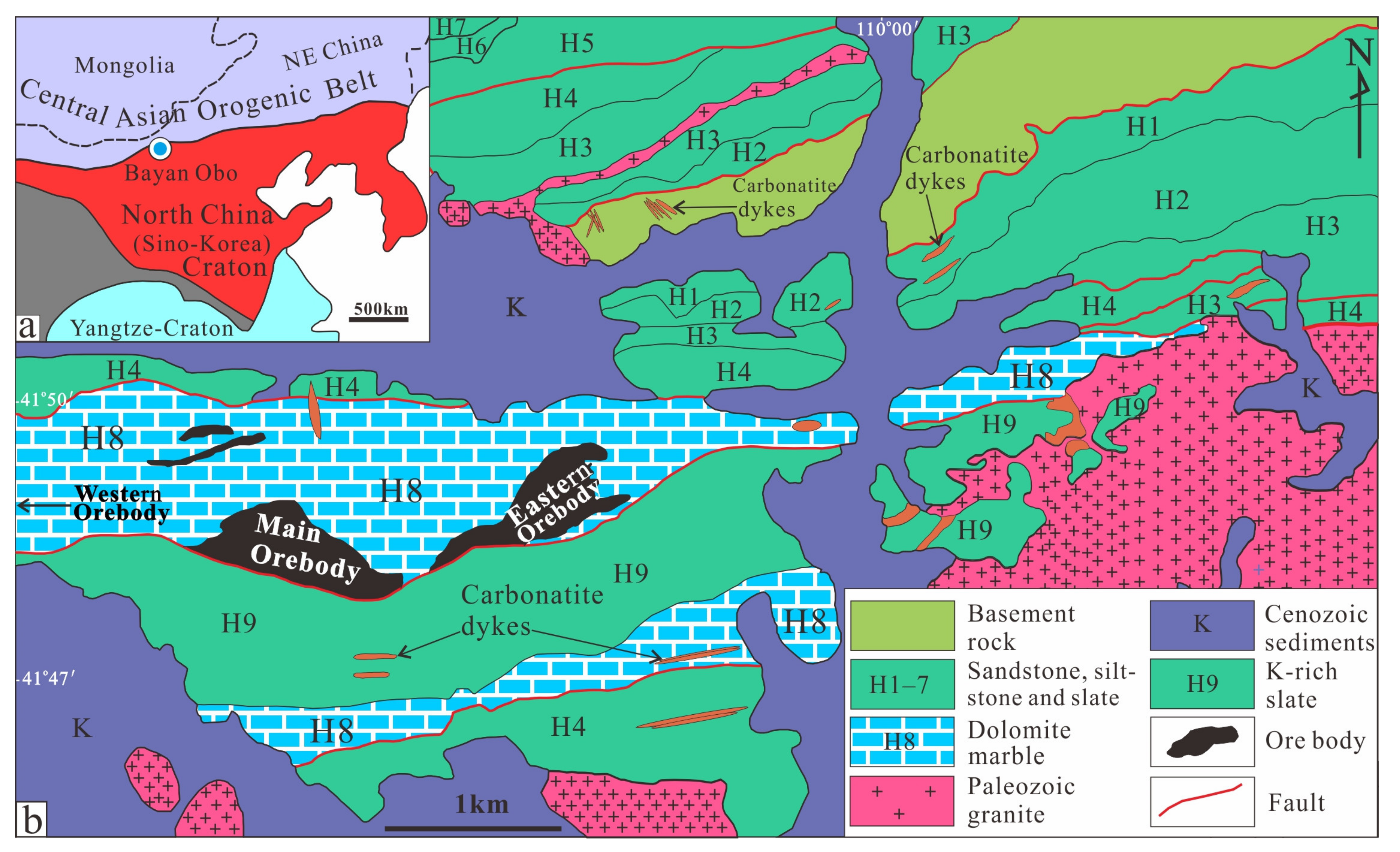
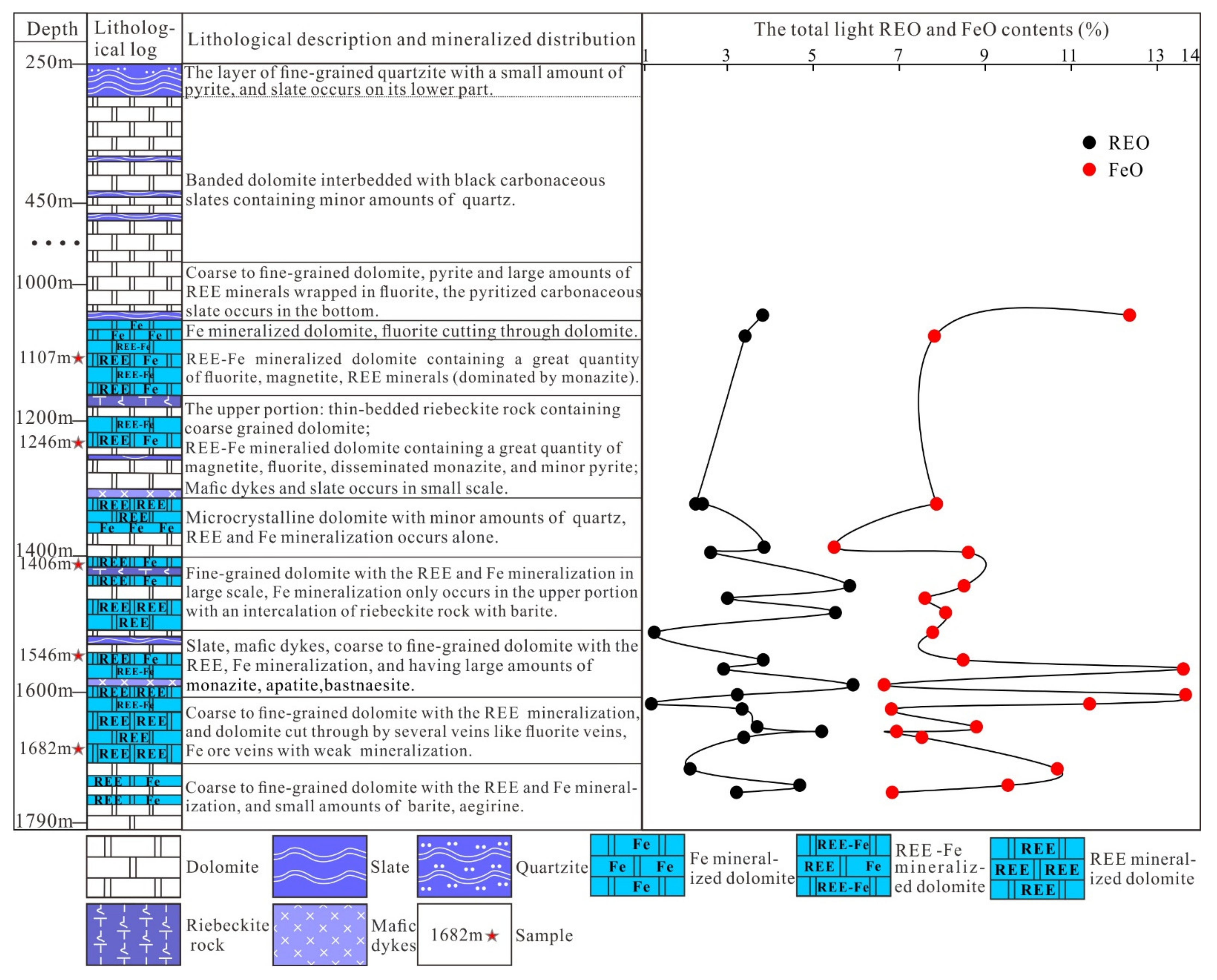
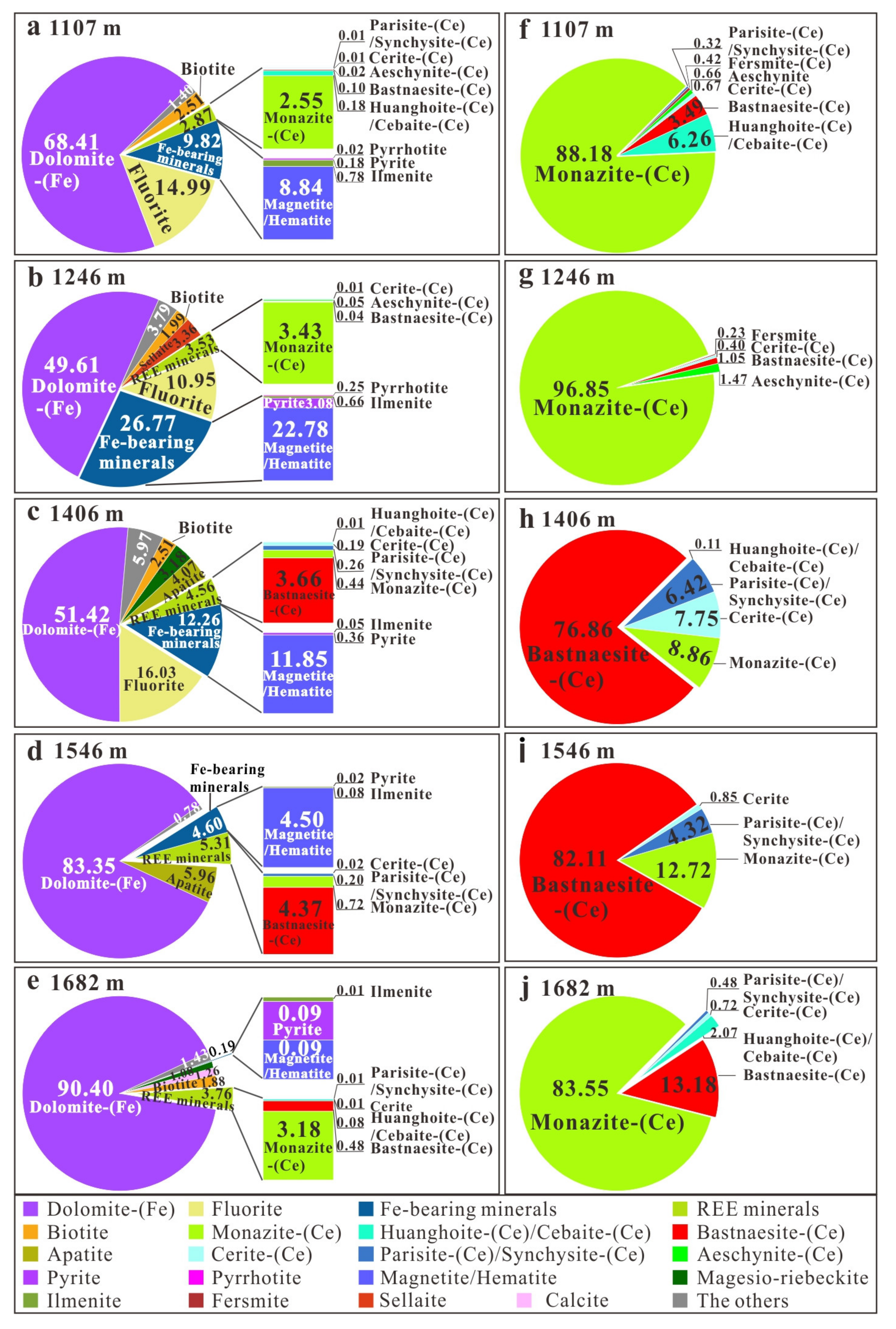
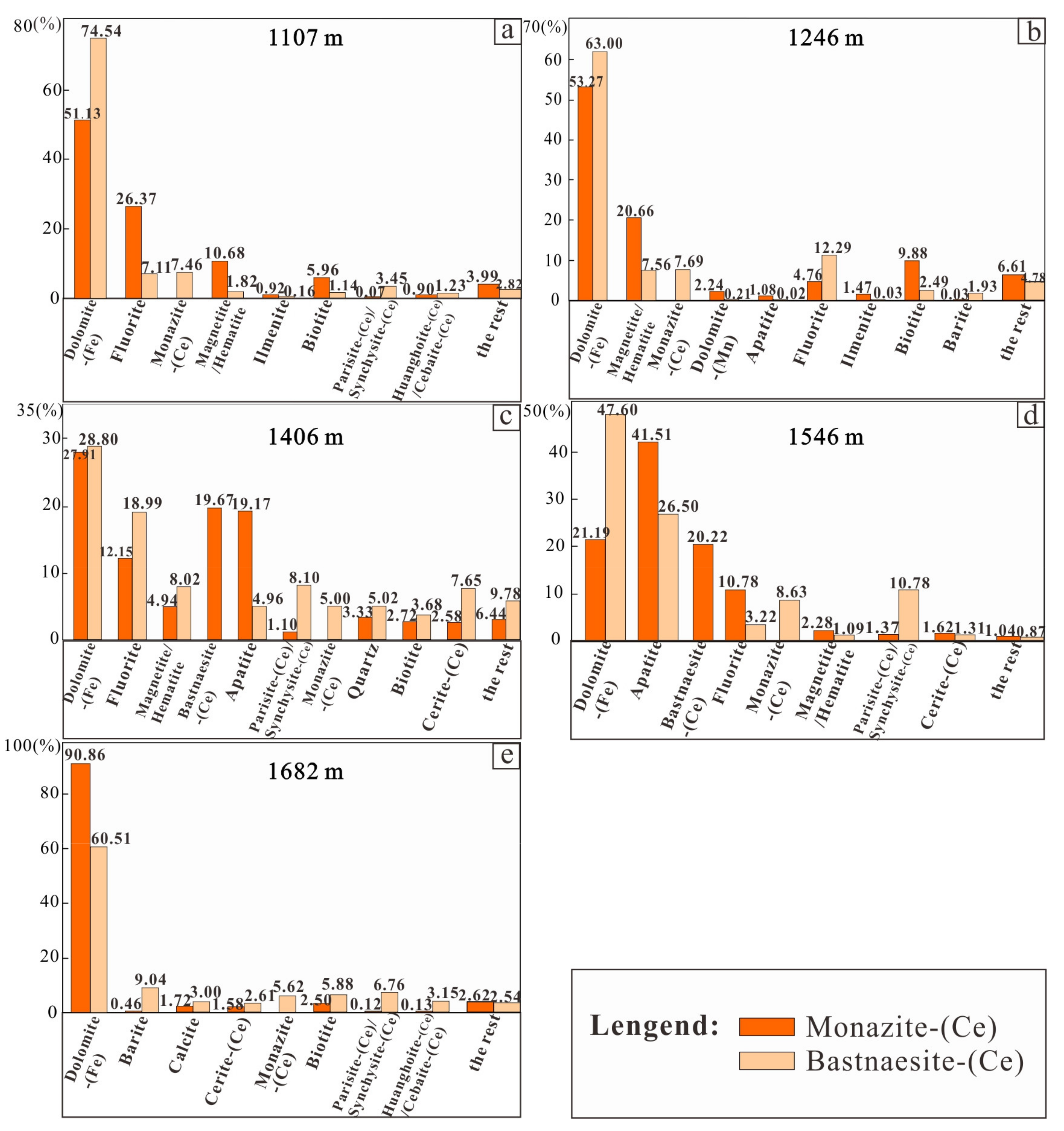
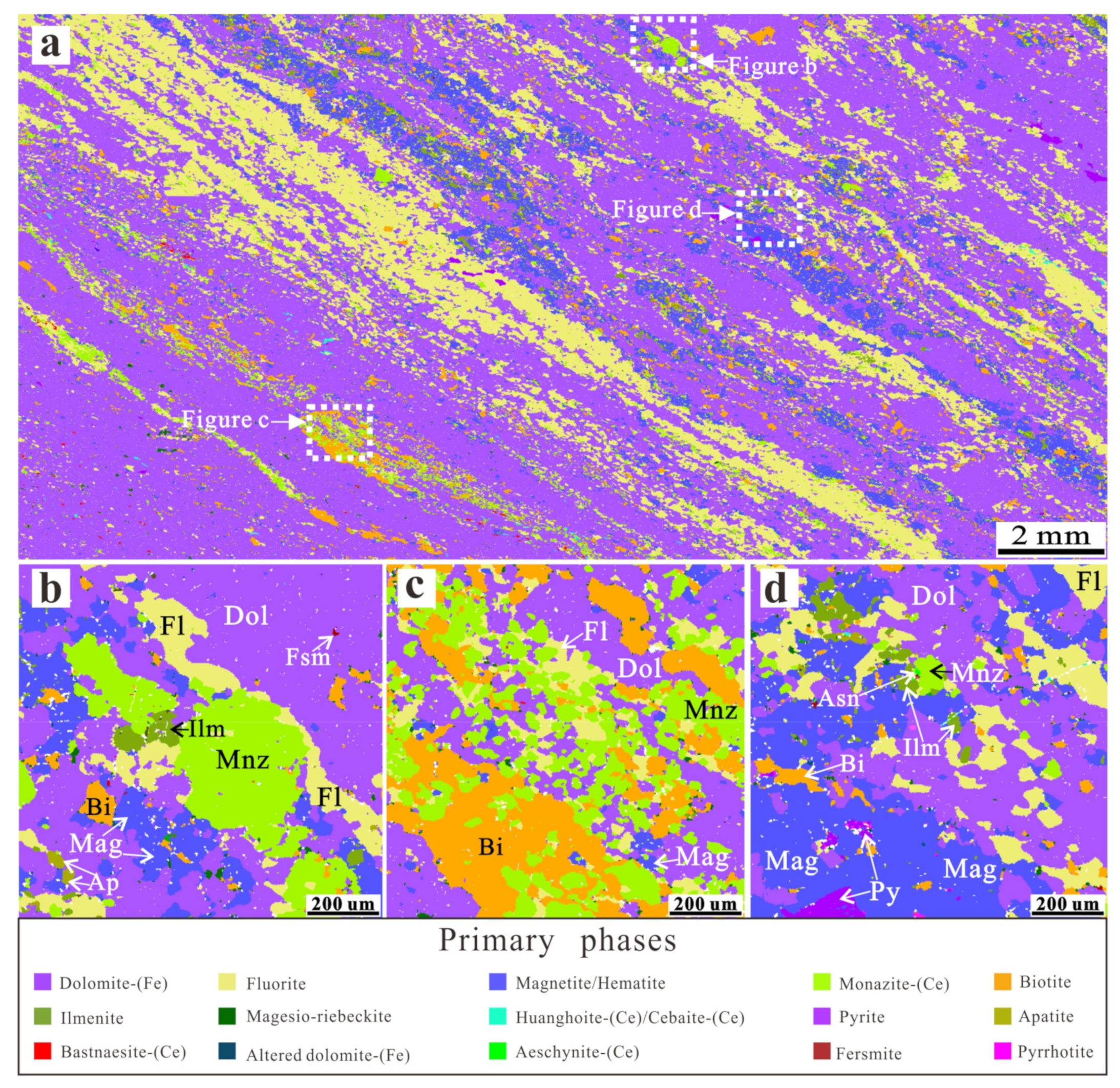

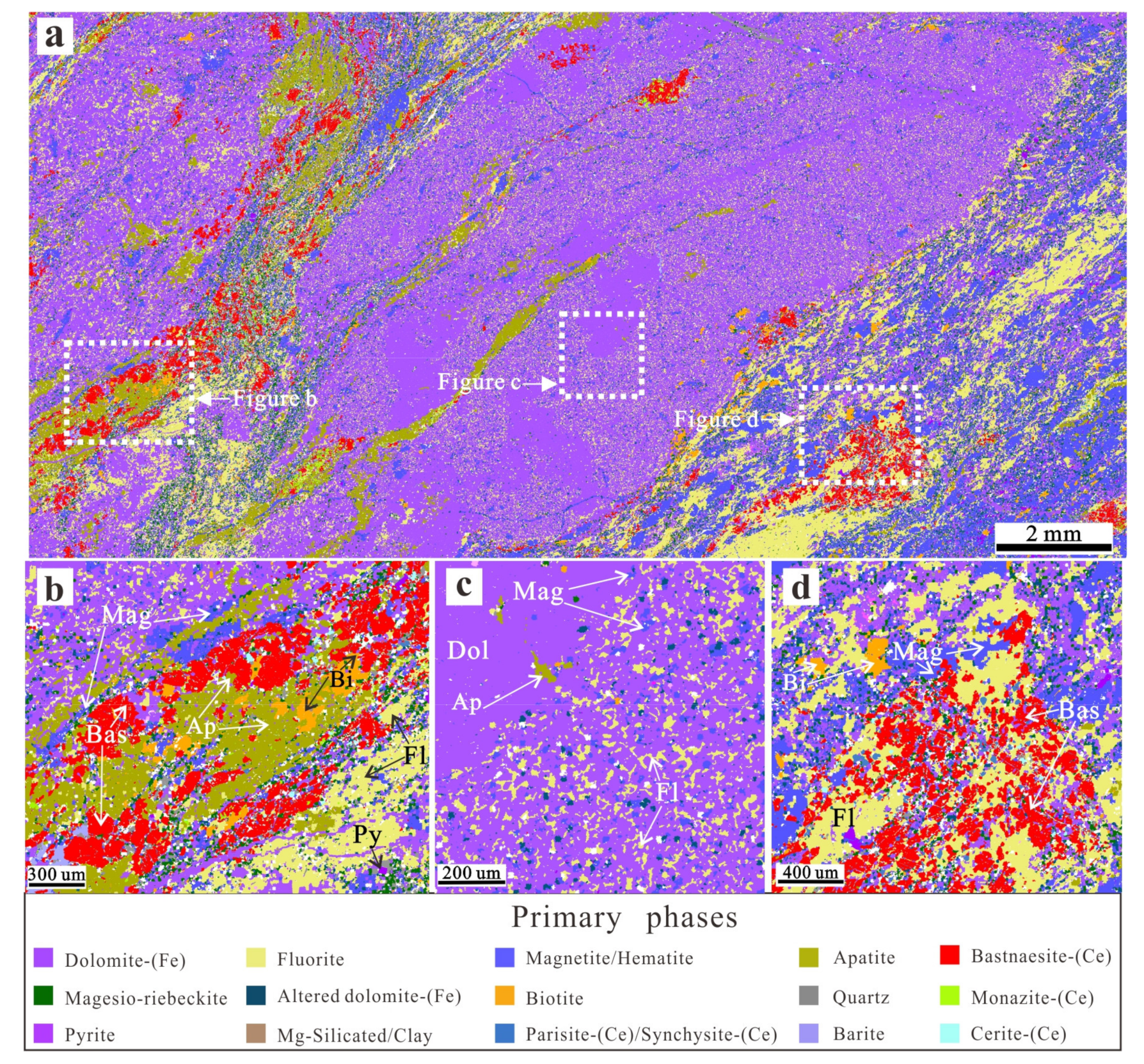
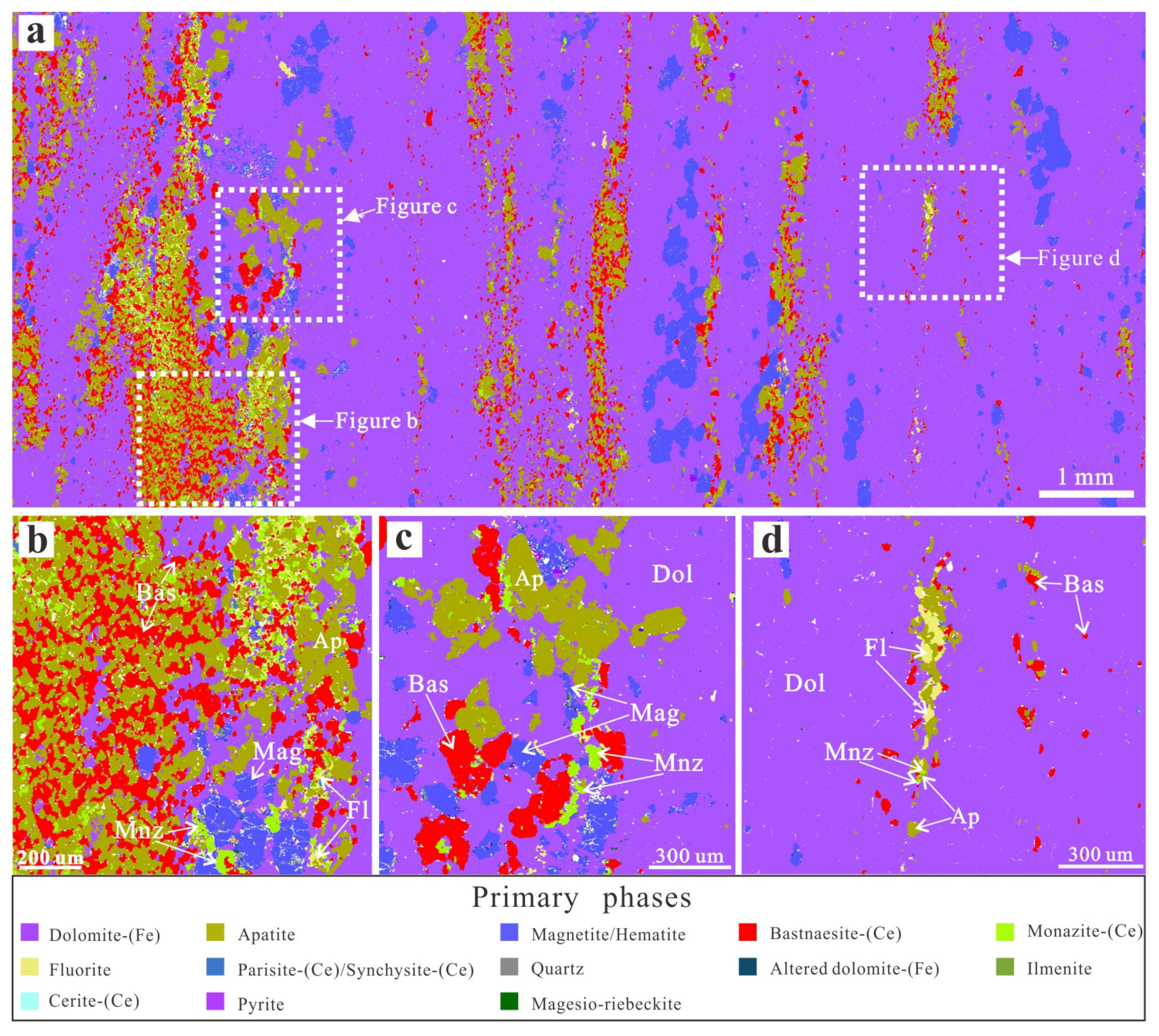

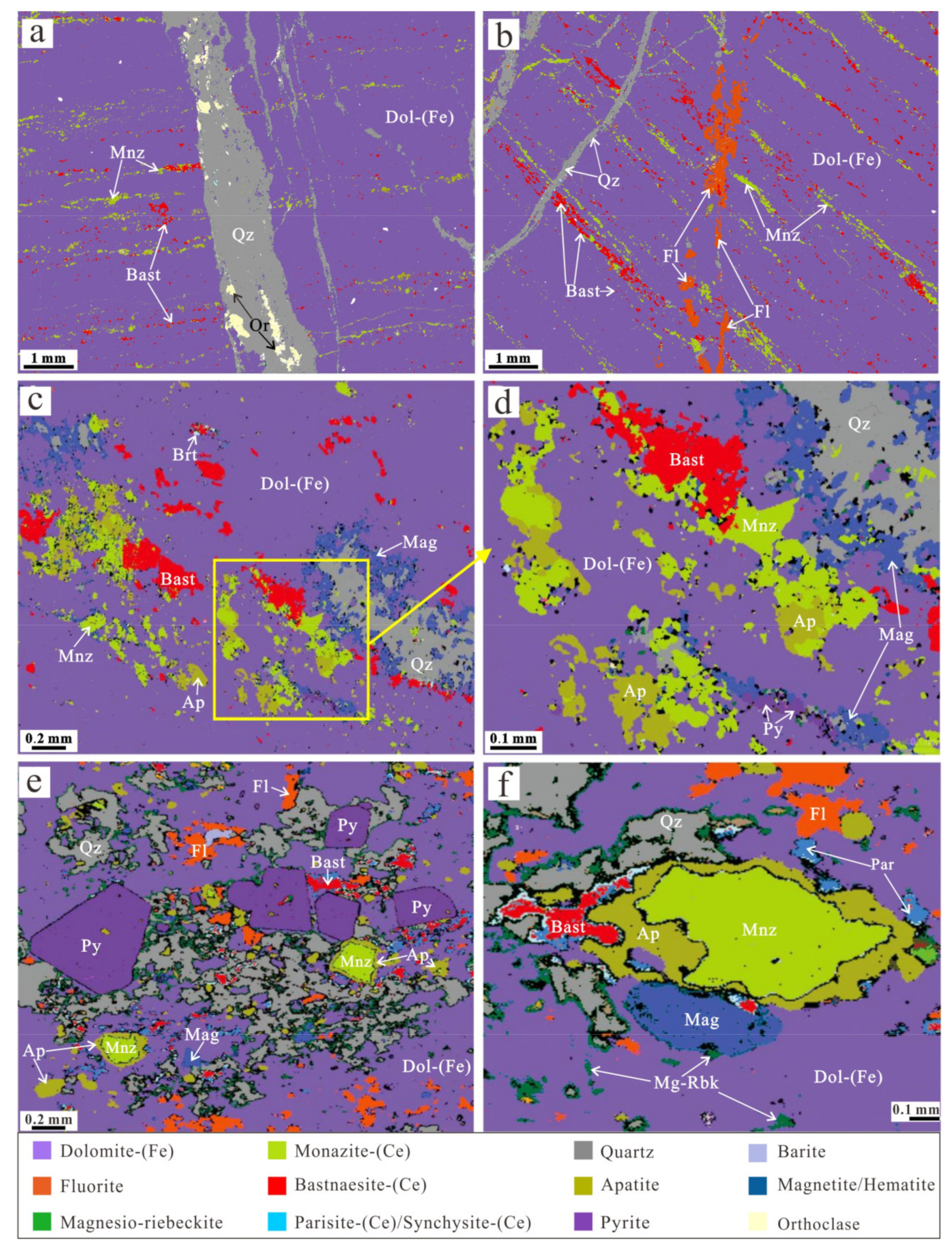
| Mineral Name | EDS Elemental Spectral Lines | Depth and Mineral Abundance | ||||
|---|---|---|---|---|---|---|
| 1107 m | 1246 m | 1406 m | 1546 m | 1682 m | ||
| Dolomite-(Fe) | Ca-K, Mg-K, Fe-K | 68.41 | 49.61 | 51.42 | 83.35 | 90.40 |
| Magnetite/Hematite | Fe-K, O-K | 8.84 | 22.78 | 11.85 | 4.50 | 0.09 |
| Fluorite | Ca-K, F-K | 14.99 | 10.95 | 16.03 | 0.35 | 0.01 |
| Monazite-(Ce) | P-K, O-K, La-L, Ce-L, Nd-L | 2.55 | 3.43 | 0.44 | 0.72 | 3.18 |
| Apatite | Ca-K, P-K, O-K, F-K | 0.18 | 0.05 | 4.07 | 5.96 | 0.00 |
| Quartz | Si-K, O-K | 0.01 | 0.02 | 1.53 | 0.02 | 0.50 |
| Biotite | K-K, Al-K, Si-K, Mg-K, Fe-K | 2.51 | 1.99 | 2.51 | 0.01 | 1.88 |
| Bastnäsite-(Ce) | Ca-K, La-L, Ce-L, F-K, P-K | 0.10 | 0.04 | 3.66 | 4.37 | 0.48 |
| Mg-silicate/clay | Mg-K, Si-K, Al-K, K-K, Ca-K, Fe-K | 0.06 | 2.59 | 0.33 | 0.00 | 0.11 |
| Magnesio-riebeckite | Na-K, Mg-K, Ca-K, Fe-K, Al-K, Si-K | 0.42 | 0.05 | 3.18 | 0.02 | 1.08 |
| Pyrite | Fe-K, S-K | 0.18 | 3.08 | 0.36 | 0.02 | 0.09 |
| Sellaite | Mg-K, F-K | 0.00 | 3.36 | 0.00 | 0.00 | 0.00 |
| Altered dolomite-(Fe) | Mg-K, Ca-K, F-K, Fe-K | 0.07 | 0.13 | 2.81 | 0.10 | 0.01 |
| Calcite | Ca-K, Mg-K, Fe-K, | 0.01 | 0.02 | 0.02 | 0.00 | 1.26 |
| Ilmenite | Ti-K, Fe-K, O-K, Mn-K | 0.78 | 0.66 | 0.05 | 0.08 | 0.01 |
| Parisite-(Ce)/Synchysite-(Ce) | Ca-K, La-L, Ce-L, F-K, S-K | 0.01 | 0.00 | 0.26 | 0.20 | 0.01 |
| Barite | Ba-L, S-K | 0.00 | 0.02 | 0.24 | 0.00 | 0.12 |
| Dolomite-(Mn) | Ca-K, Mg-K, Fe-K, Mn-K | 0.01 | 0.36 | 0.00 | 0.00 | 0.00 |
| Pyrrhotite | Fe-K, S-K | 0.02 | 0.25 | 0.00 | 0.00 | 0.00 |
| Huanghoite-(Ce)/Cebaite-(Ce) | Ce-L, Ba-L, F-K | 0.18 | 0.00 | 0.01 | 0.00 | 0.08 |
| Cerite-(Ce) | Si-K, La-L, Ce-L, Nd-L | 0.01 | 0.01 | 0.19 | 0.02 | 0.01 |
| Columbite-(Fe) | O-K, Ti-K, Mn-K, Fe-K, Ta-M | 0.03 | 0.02 | 0.01 | 0.01 | 0.00 |
| Sphalerite | Zn-K, Zn-L, S-K | 0.02 | 0.08 | 0.01 | 0.00 | 0.00 |
| Fersmite | Ca-K, Nb-L, Ce-L, Ti-K, Ta-M, Fe-K | 0.05 | 0.04 | 0.00 | 0.00 | 0.00 |
| Aeschynite-(Ce) | Nd-L, Th-L, Fe-K, Ti-K, Nb-L | 0.02 | 0.05 | 0.00 | 0.00 | 0.00 |
| Galena | Pb-L, Pb-M, S-K | 0.00 | 0.02 | 0.03 | 0.00 | 0.00 |
| Rutile-Nb | Nb-L, Ti-K, Fe-K, Si-K | 0.00 | 0.00 | 0.00 | 0.01 | 0.00 |
| The rest * | - | 0.54 | 0.39 | 0.99 | 0.26 | 0.68 |
| Mineral Name | 1107 m | 1246 m | 1406 m | 1546 m | 1682 m |
|---|---|---|---|---|---|
| Monazite-(Ce) | 88.18 | 96.85 | 8.86 | 12.72 | 83.55 |
| Bastnäsite-(Ce) | 3.49 | 1.05 | 76.86 | 82.11 | 13.18 |
| Parisite-(Ce)/Synchysite-(Ce) | 0.32 | - | 6.42 | 4.32 | 0.48 |
| Cerite-(Ce) | 0.67 | 0.40 | 7.75 | 0.85 | 0.72 |
| Huanghoite-(Ce)/Cebaite-(Ce) | 6.26 | - | 0.11 | - | 2.07 |
| Aeschynite-(Ce) | 0.66 | 1.47 | - | - | - |
| Fersmite-(Ce) | 0.42 | 0.23 | - | - | - |
Publisher’s Note: MDPI stays neutral with regard to jurisdictional claims in published maps and institutional affiliations. |
© 2022 by the authors. Licensee MDPI, Basel, Switzerland. This article is an open access article distributed under the terms and conditions of the Creative Commons Attribution (CC BY) license (https://creativecommons.org/licenses/by/4.0/).
Share and Cite
Liu, T.; Song, W.; Kynicky, J.; Yang, J.; Chen, Q.; Tang, H. Automated Quantitative Characterization REE Ore Mineralogy from the Giant Bayan Obo Deposit, Inner Mongolia, China. Minerals 2022, 12, 426. https://doi.org/10.3390/min12040426
Liu T, Song W, Kynicky J, Yang J, Chen Q, Tang H. Automated Quantitative Characterization REE Ore Mineralogy from the Giant Bayan Obo Deposit, Inner Mongolia, China. Minerals. 2022; 12(4):426. https://doi.org/10.3390/min12040426
Chicago/Turabian StyleLiu, Taotao, Wenlei Song, Jindrich Kynicky, Jinkun Yang, Qian Chen, and Haiyan Tang. 2022. "Automated Quantitative Characterization REE Ore Mineralogy from the Giant Bayan Obo Deposit, Inner Mongolia, China" Minerals 12, no. 4: 426. https://doi.org/10.3390/min12040426
APA StyleLiu, T., Song, W., Kynicky, J., Yang, J., Chen, Q., & Tang, H. (2022). Automated Quantitative Characterization REE Ore Mineralogy from the Giant Bayan Obo Deposit, Inner Mongolia, China. Minerals, 12(4), 426. https://doi.org/10.3390/min12040426






